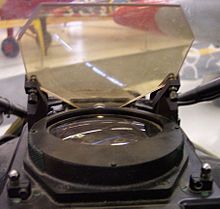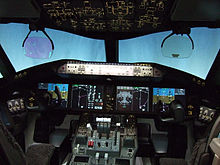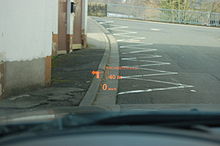Head-Up Display


The head-up display ( HUD ; literally: "head-up display") is a display system in which the user can maintain his head posture or line of sight, because the information is projected into his field of vision . Users include pilots and drivers, among others.
introduction
Such systems have existed for pilots of fighter aircraft since the 1940s. In Germany they became known as reflex sights (target devices). Around thirty years later, systems emerged that could be described as complex front screen projectors. A typical feature of a front screen projector is the second screen in the cockpit, onto which various information can then be projected. Nowadays, the head-up display is by far the most important display in the cockpit. The HUD displays information from a variety of sources, such as avionics , radar, or weapon systems, all in a compact, manageable form. The pilot has a selection of different modes available for the head-up display, which he can choose depending on the respective order or the status of his mission. Each mode supports the pilot in a very specific task, be it z. B. in navigation, when using different guided weapons or when landing.
In the meantime, these systems are also used in the latest civil jet types. B. Airbus A350 and Boeing 787 . Older aircraft can also be retrofitted with such systems if necessary.
In the 1980s and 1990s, General Motors in the USA had a black and white head-up display with fixed, non-configurable displays in various car models. B. always had the current speed in view without having to take your eyes off the road. Even with Nissan , there were already some models such. B. the Nissan 240SX .
A color display was used for the first time in the General Motors Corvette from 2001 .
BMW was the first European manufacturer to launch a head-up display developed by Siemens VDO Automotive AG in large-scale production in the 5 and 6 model series presented in 2003, followed in 2005 by PSA with the Citroën C6 . Automobile manufacturers and automotive suppliers are now working on head-up displays with 3D and augmented reality functions.
Head-up displays are offered by various manufacturers. There are also devices for retrofitting; Garmin offers a model that is linked to a smartphone via Bluetooth and projects information onto the windshield via a navigation app. Other manufacturers offer head-up displays for retrofitting, which can read out information via the vehicle's OBD-II diagnosis and thus display details on speed, engine speed or engine temperature.
Cabinets of older arcade machines often also contain a head-up display, as this means that the machine's center of gravity moves downwards by moving the heavy picture tube into the base and the machine becomes more stable. Instead of a semi-transparent pane of glass, a normal mirror is built into the player's line of sight. With the introduction of TFT screens in slot machine technology, this application has become rare.
In current computer games , on the other hand, head-up displays are generally used to denote status displays that do not belong to the virtual environment, but are statically positioned at the edges of the field of vision. Other computer programs are also increasingly being equipped with head-up displays.
How a head-up display works
Head-up displays generally consist of an imaging unit, an optics module and a projection surface.
The imaging unit generates the image. The optics module with collimator and deflection guides the image onto the projection surface ( combiner ). This surface is a reflective, translucent pane. The user of the front screen projector sees the mirrored information from the imaging unit and at the same time the real world behind the screen.
The generated virtual image can be projected so that it can be captured with one eye ( monocular ) or with both eyes ( binocular ). Binocular HUDs have a higher field of view than monocular. In aircraft, the virtual image is always projected into infinity, but in vehicle applications it is 2–3 m in front of the hood - so that the driver is not distracted when cornering.
The pilot of a jet adjusts the view through the HUD before take-off by adjusting the height of his seat.
In aircraft technology, small special picture tubes were used to generate the corresponding image. Picture tubes generate a very high luminance, so no additional light source is required. In the case of picture tubes, two different techniques are used for the image display: the bright oscillographic (vector) display or the television (line) display.
Today (2016) light- emitting diodes serve as a light source . The brightness of the image is controlled by a photo sensor depending on the ambient light. The image is generated by a colored high-resolution TFT display .
The Swiss company WayRay is developing a technology with a special laser as a light source and a holographic display of the displayed image information as augmented reality ( True AR ).
Information content of a head-up display
The important information of a HUD can be divided into:
- static information and
- contact-analog information.
Static information
Static information is information that is always in the same place in the driver's field of vision. Examples of this are the vehicle speed and the engine speed. The driver has the feeling that the information can be seen on a vertical plane roughly above the bonnet. In an airplane, there are things like altitude and speed or the weapon load. This is very different, depending on which operating mode of the avionics system is currently being used (navigation, radar or, for example, close-range aerial combat).
Contact-analog information
Contact-analog information is display elements that are shown to the driver in his current view in such a way that he has the feeling that it is an integral part of the environment. This makes a navigation arrow appear as if it were directly on the street. In the case of the safety distance bar, this means that the driver is shown a speed-dependent bar in the windshield area that tells him how much distance he should keep from the vehicle in front. In the combat aircraft, for example, the visually visible target is also marked by a light circle. This signals that the machine's sensor systems ( radar , IR) have detected the target and are accompanying it. In addition, a large amount of other information relating to the target is displayed (forecast, distance, friend-foe identification).
Another application is the insertion of an image from a night vision or infrared camera in order to simplify orientation (and target acquisition in a fighter aircraft) in the dark.
See also
literature
- Rolf Gengenbach: Driver behavior in a car with a head-up display. Habituation and visual attention . Progress reports VDI, series 12: Traffic engineering / vehicle technology, No. 330. VDI-Verlag, Düsseldorf 1997, ISBN 3-18-333012-1
- S. Okabayashi et al .: Visual Perception of HUD Images in Practical Automobiles (p. 169–176) and Philip Barham et al .: Jaguar Cars' Near Infrared Night Vision System - Overview of Human Factors Research to Date (p. 177– 185). Both in AG Gale (ed.): Vision in Vehicles - VIII . Elsevier, Amsterdam 1999, ISBN 0-08-043671-4
- P. Ott, P. Pogany: Optical design of head-up displays with CAD-compatible free-form surfaces. , Photonik 2 (2008), pp. 68-71
Web links
Individual evidence
- ↑ Head-up display: New technology for more road safety, Joachim Kaufmann, ZDNet, October 20, 2004, 4:52 p.m.
- ↑ Everything in view, Thomas Geiger, Spiegel Online, May 13, 2003
- ↑ Head-up displays of the next generation - automotive technology . In: Automotive Technology . May 19, 2017 ( automotive-technology.de [accessed May 22, 2017]).
- ↑ SASAKI, Takashi, et al. Hyperrealistic Display for Automotive Application. In: SID Symposium Digest of Technical Papers. Blackwell Publishing Ltd, 2010. Chapter 64.2. Pp. 953-956 doi : 10.1889 / 1.3500641
- ↑ Porsche invests in Swiss start-up WayRay. Porsche Media Center, September 18, 2018, accessed on May 24, 2020
- ↑ Herbie Schmidt: The head-up display grows to the size of a windshield. NZZ, May 23, 2020, accessed on May 23, 2020
- ↑ Patent US 6,359,737 B1 (March 19, 2002). STRINGFELLOW, Steven A .: Combined Head-Up Display


